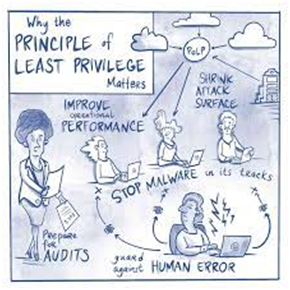Understanding the Principle of Least Privilege
The Principle of Least Privilege is a cybersecurity concept centered on limiting user and system access rights to the bare minimum necessary to accomplish their tasks. In simpler terms, individuals or systems are granted only the permissions essential to perform their specific functions and nothing more. This method greatly lowers the possible harm that could result from abuse or illegal access.
Implementing PoLP in IoT
When applied to the IoT landscape, the Principle of Least Privilege becomes a critical tool in ensuring the security and integrity of interconnected devices and networks. Here’s how it can be effectively implemented in IoT environments:
- Role-Based Access Control (RBAC): Assign roles to various entities within the IoT ecosystem based on their functions and responsibilities. The fewest privileges necessary for any function to carry out its responsibilities should be granted.For example, a sensor node should only have access to the data it needs to collect and nothing beyond that.
- Segmentation of Networks: Divide the IoT network into discrete parts and isolate its various components. This helps in limiting the propagation of a potential security breach, ensuring that an intrusion in one segment does not compromise the security of the entire network.
- Regular Audits and Monitoring: Regularly monitor and audit the access and activities of users and devices within the IoT network. This ensures that access rights remain appropriate and are adjusted as necessary, based on changes in roles or responsibilities.
- Encryption and Authentication: To safeguard data both in transit and at rest, implement strong encryption methods. Additionally, enforce strong authentication methods to validate the identities of users and devices, ensuring that only authorized entities have access.
Applying PoLP within an Organization
The principles of least privilege extend beyond IoT and are equally crucial within the organizational setting. Here’s how organizations can integrate this principle for enhanced security and efficiency:
- User Access Management: Define and limit user access to various systems and data based on their job roles. Only the resources required for them to carry out their jobs well should be available to them.
- Regular Access Reviews: Review user access privileges regularly to make sure they still correspond with the duties of the job. When an employee leaves the company or changes jobs, access permissions might be changed or removed.
- Automated Access Provisioning and Deprovisioning: Implement automated systems for granting and revoking access rights as per defined roles. This guarantees a timely modification of access credentials and lowers the possibility of human mistake.
- Education and Training: Train staff members of the value of the Least Privilege Principle and how it enhances the security of the company. Attending training sessions can greatly improve adherence to this idea.
Best Practices for Successful Implementation
To ensure a successful implementation of the Principle of Least Privilege (PoLP) within both IoT environments and organizations, here are some best practices:
- Regular Security Assessments: Perform routine security assessments and penetration testing to identify vulnerabilities and weaknesses in the system. This proactive approach helps in refining access rights and ensuring alignment with the PoLP.
- Documentation and Access Policies: Maintain comprehensive and up-to-date documentation of access policies, user roles, and associated access levels. Clear and well-defined policies aid in the consistent application of the PoLP and provide a reference for audits and reviews.
- Incident Response Plans: Create thorough incident response plans that specify the steps to be taken in the event of an intrusion or unauthorized access. This guarantees a prompt and efficient reaction to reduce possible harm.
- Continuous Monitoring and Logging: Implement continuous monitoring mechanisms and logging systems to track user and system activities. Analyzing these logs can help in identifying any deviations from the least privilege model and potential security threats.
- Collaboration and Communication: Encourage teams in charge of end users, IT operations, and security to work together and communicate openly. The successful implementation of PoLP throughout an organization depends on collaboration and awareness.
Benefits of Adhering to PoLP
Implementing the Principle of Least Privilege offers several advantages for both IoT ecosystems and organizational cybersecurity:
- Enhanced Security: By restricting access to the bare minimum required for tasks, the attack surface is reduced, minimizing the potential for security breaches and unauthorized access.
- Risk Mitigation: Restricting access rights helps prevent both accidental and intentional misuse of privileges, keeping important data and critical systems safe from harm.
- Compliance Adherence: Following the Principle of Least Privilege helps organizations meet different rules and standards that focus on protecting data and privacy.
- Operational Efficiency: With clearly defined roles and access levels, organizations can optimize workflows and increase operational efficiency by ensuring that employees have access only to what they need to perform their roles.
- Cost Reduction: By minimizing access to unnecessary resources, organizations can reduce costs associated with potential security incidents, compliance fines, and unnecessary licensing fees.
Challenges and Considerations in Implementing PoLP
While the Principle of Least Privilege (PoLP) is crucial for securing IoT and organizational environments, its implementation is not without challenges. Understanding and addressing these challenges is vital to apply PoLP effectively:
- Complexity of IoT Ecosystems: IoT ecosystems often involve a myriad of devices, protocols, and platforms, each with unique security requirements and capabilities. Managing and enforcing the principle across this complexity requires a well-defined and adaptable approach.
- Scalability Issues: As IoT networks expand, managing access rights for a growing number of devices and users becomes increasingly challenging. Scalable solutions and automation are necessary to maintain the principle’s effectiveness at scale.
- Interoperability: Different IoT devices and systems may have varying levels of security capabilities and protocols. Ensuring interoperability while enforcing the principle is crucial to maintaining a cohesive security posture.
- User Education and Awareness: In companies, it’s important for employees to understand and follow the Principle of Least Privilege (PoLP). Teaching them about security helps them use this principle effectively.
- Balancing Security and Functionality: Striking the right balance between restricting access to minimize risk and allowing sufficient access for operational efficiency is a delicate task. We need to make sure that our security measures don’t get in the way of important business activities.
Application of PoLP in IoT
In the realm of the Internet of Things (IoT), the Principle of Least Privilege is crucial for enhancing security. In IoT, applying this method means restricting access to data, resources, applications, and functions only to what’s needed for a user or entity to do their job. This helps decrease the chances of cyber-attacks by making the system less vulnerable and limiting unauthorized access.
In Zero Trust Network Access (ZTNA) 2.0, PoLP ensures accurate recognition of applications and their specific functions across different ports and protocols, even dynamic ones. This removes the necessity for administrators to concentrate on network structures, allowing detailed access control and thorough least-privileged access.
The advantages of implementing PoLP include:
- Minimized Attack Surface: By protecting superuser and administrator privileges and limiting access, PoLP reduces the avenues malicious actors can use to access sensitive data or initiate an attack.
- Reduced Malware Propagation: PoLP prevents unauthorized applications from being installed, thereby stopping lateral network movement that could lead to malware spread.
- Improved Operational Performance: By minimizing system downtime resulting from breaches or malware spread, PoLP enhances operational performance and reduces incompatibility issues between applications.
- Safeguard Against Human Error: By restricting access to the bare minimum required, PoLP helps mitigate risks associated with human errors, whether accidental, intentional, or negligent.
Future Outlook: PoLP in a Rapidly Evolving Landscape
Looking ahead, the rapid evolution of technology, especially within IoT, will undoubtedly pose new challenges and opportunities for implementing the Principle of Least Privilege. Here are some considerations for the future:
- Advanced Access Control Mechanisms: Incorporating advanced access control technologies such as Zero Trust Architecture (ZTA) will be essential. ZTA operates on the PoLP principle, treating every access request as potentially risky, regardless of the location or source.
- AI and Machine Learning Integration: Leveraging AI and machine learning for analyzing user and system behavior can enhance PoLP by dynamically adjusting access privileges based on usage patterns, anomalies, and real-time threats.
- Regulatory Compliance Demands: With an increasing focus on data privacy and security regulations, adherence to the PoLP will become a compliance requirement. Organizations and IoT developers must integrate PoLP into their strategies to meet evolving regulatory demands.
- Continuous Adaptation and Evolution: Given the dynamic nature of both IoT and cybersecurity threats, organizations and IoT ecosystems must commit to continuously adapting and evolving their PoLP strategies. Regular updates and adjustments will be vital to maintain a strong security posture.
In conclusion, embracing the Principle of Least Privilege in both IoT and organizational settings is crucial for fortifying security and enhancing efficiency. By adhering to this principle, businesses can significantly reduce risks, improve operational performance, and maintain a strong security posture in an ever-evolving digital landscape.
References:
https://www.techtarget.com/searchsecurity/definition/principle-of-least-privilege-POLP














